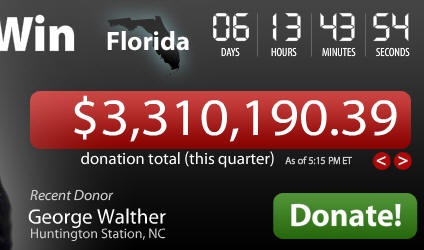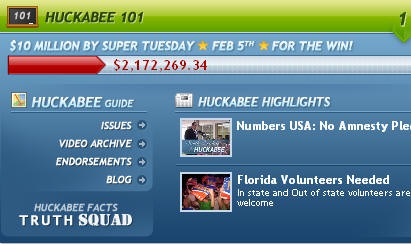I think the most interesting move a campaign has made this cycle is Ron Paul’s decision to be completely transparent in his fundraising. For the last five or six months the central element of Ron Paul’s homepage has been a counter that tallies how much he has raised during the current quarter. A screen shot of the graphic is below.

In addition to this graphic, the Paul campaign has also published a feed of all its donation data that volunteers can access. This has lead others, such as Ron Paul Graphs, to do mash ups showing donation statistics. If I want to know how much Ron Paul is raising, I can go to any number of sites and get a real time number. This is in stark contrast to most of the other campaigns that, for the most part, keep fundraising information under wraps until they are forced to disclose the information publicly.
Others have followed Paul’s lead to some extent. The Huckabee campaign has a tally of quarterly fundraising on their site.

Other campaigns have played with the idea of transparency in the context of specific fundraising efforts (meaning efforts to raise X dollars by X date). Howard Dean had his bat back in 2004 that showed progress towards goals. On the Fred Thompson campaign, we had our red truck, which was successful. The Barack Obama and John Edwards campaign have run similar fundraising pushes this cycle.
While I certainly wouldn’t advise every candidate to mimic what the Paul campaign is doing, I do think there is something to this transparent fundraising concept. Here are the benefits to the approach as I see them:
(1) Volunteers feel more a part of the campaign when they have access to fundraising numbers. They will take responsibility for moving the number and be more motivated to fundraise on a campaign’s behalf. Transparency also allows people to do cool stuff like money bombs. You end up creating a vibrant fundraising community of online donors/fundraisers that wouldn’t be possible without transparency.
(2) Your site will attract more visitors as supporters and the curious check back frequently to check the numbers. These people will end up sticking around to read other content and complete other activities. It makes supporters more likely to become volunteers.
(3) I think having a counter showing up-to-the minute donation information makes normal people more likely to give. There is something cool about getting the immediate feedback of watching a number increase after making a donation.
Obviously, there are down sides here. The media is watching too and will bury you if your numbers stink. What is innovative now may feel a bit gimmicky as more and more campaigns try the idea. It seems like the tactic of an insurgent candidate as opposed to a more established front runner.
But, all in all, I think there is something to the concept and I’d expect to see more of it in the coming days.
What do you think?
Sign up today to have our latest posts delivered straight to your inbox.